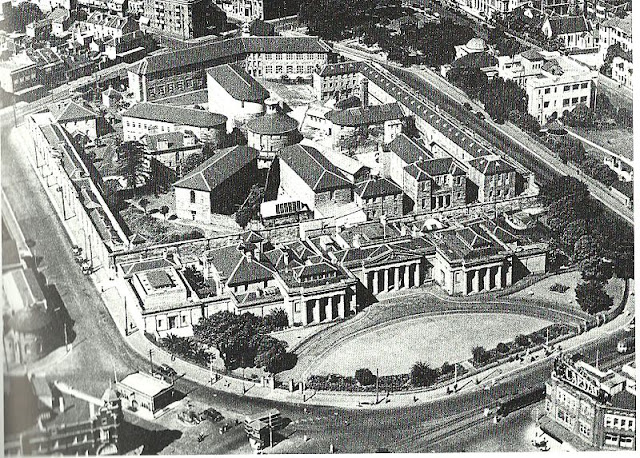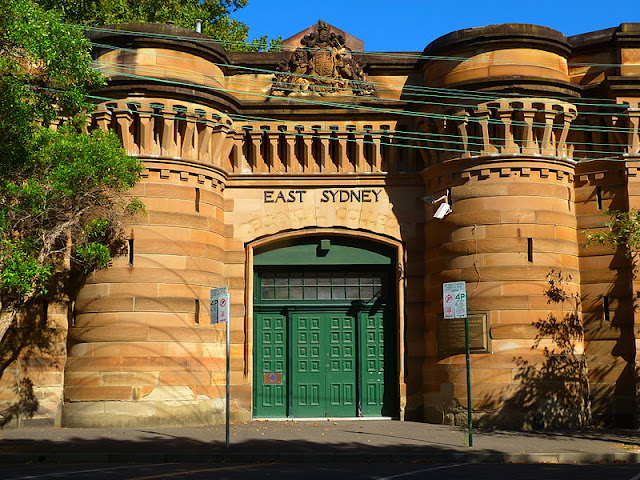__________
Location:
Darlinghurst, often colloquially referred to as "Darlo", is located immediately east of the Sydney central business district and Sydney’s Hyde Park, within the local government area of the City of Sydney.
__________
Name origin:
The suburb was originally known as Eastern Hill and then Henrietta Town, after Governor Lachlan Macquarie's wife, whose second name was Henrietta.
Lachlan Macquarie, CB (1762 – 1824), fifth Governor of New South Wales from 1810 to 1821.
Elizabeth Macquarie, née Elizabeth Henrietta Campbell (1778–1835), the second wife of Lachlan Macquarie. She played a significant role in the establishment of the colony and is recognised in the naming of many Australian landmarks including Mrs Macquarie's Chair and Elizabeth Street, Hobart and Sydney. Governor Macquarie named the town (now city) of Campbelltown, New South Wales after his wife's maiden name and a statue of her now stands in Mawson Park, Campbelltown.
Elizabeth Macquarie Statue, Mawson Park, Campbelltown
The loyalties changed with the change of governors and the suburb became Darlinghurst in honour of Elizabeth Darling, the popular wife of Governor Ralph Darling, during the early 19th century. The suffix 'hurst' is derived from the Old English word hyrst, meaning wooded area.
Ralph Darling (1772[2] – 1858), British Army officer who served as Governor of New South Wales from 1825 to 1831. He is popularly described as a tyrant, accused of torturing prisoners and banning theatrical entertainment. Local geographical features named after him include the Darling River and Darling Harbour in Sydney.
Elizabeth Darling (1798–1868), the wife of Sir Ralph Darling, Governor of New South Wales from 1825 to 1831. During her six years in NSW, her charity work was extensive and ground-breaking, on behalf of some of the most marginalised and powerless members of her society – convict women, girls from poor families and women in need of medical care. Eliza was among the founders of the Sydney Female School of Industry, of which, as the Governor’s wife, she became patroness and to which she was a frequent visitor. It was the first colonial charity to be founded and managed entirely by women, and it continued until 1926. Its purpose was to educate poor working-class girls in the skills they would need to find employment as domestic servants, as well as to provide them with the religious and moral grounding its founders believed they would need to live honest and useful lives. Eliza’s interest in the School continued even after she and her husband returned to England.
In 1826, Eliza established the Female Friendly Society of the Town of Sydney, open to “females of good character between the ages of fourteen and fifty”, as the first friendly society in the colony of New South Wales. Female friendly societies ascribed value to both, and made provision for medical treatment, hospitalisation and funeral expenses for women who would otherwise have had no money to pay for their own care.
__________
About:
- Darlinghurst is a densely populated suburb with the majority of residents living in apartments or terraced houses.
- Once a slum and red-light district, Darlinghurst has undergone urban renewal since the 1980s to become a cosmopolitan area made up of precincts. Places such as Victoria Street (which connects Darlinghurst to Potts Point in the north), Stanley Street (Little Italy) and Crown Street (Vintage and Retro Fashion) are known as culturally rich destinations. These high street areas are connected by a network of lane-ways and street corners with shops, cafes and bars.
- Demographically, Darlinghurst is home to the highest percentage of generation X and Y in Australia.
- The majority of businesses in Darlinghurst are independently owned and operated small businesses with over 50% of all commercial activity in the area being consumer oriented: indie retail, food, drink, dining, leisure and personal services. Darlinghurst is also home to large number of off-street creative industries.
- Darlinghurst's main street is Oxford Street. This major Sydney road runs east from the south-eastern corner of Hyde Park through Darlinghurst and Paddington and terminates at Bondi Junction. Oxford Street is one of Sydney's most famous shopping and dining strips. The Darlinghurst end is well known around the world as the centre of Sydney's gay community, is the yearly parade route of the Sydney Mardi Gras and the spiritual birthplace of the LGBT rights movement. It is home to a number of prominent gay venues and businesses, while more broadly Darlinghurst is a centre of Sydney's burgeoning small bar scene.
Court House Hotel and the Rainbow Crossing on Oxford Street in Darlinghurst
Oxford Street
Café, Brick Lane, Darlinghurst
- From the 1990s onwards Oxford Street began to garner a reputation for being Sydney's primary "nightclub strip", popular with both gay and straight clubbers, surpassing the notorious red-light district of Kings Cross in popularity. As a result of the influx of revellers, crime rates increased in the area around 2007, particularly for assaults and robberies. This reported increase should be understood in terms of a very low background crime rate in East Sydney in general. The 2014 lockout laws saw many nightclubs close and the crime rate drop once again, with a new focus on small bars, restaurants and cafes after the lockout laws ended in 2020.
__________
Place of interest within Darlinghurst:
---oOo---
Australian Museum:
The Australian Museum is a heritage-listed museum at 1 William Street, Sydney. It is the oldest museum in Australia, having been established in 1827, and the fifth oldest natural history museum in the world, with an international reputation in the fields of natural history and anthropology.
---oOo---
Sydney Jewish Museum
The Sydney Jewish Museum, located in Darlinghurst, showcases exhibits relating to the Holocaust, the history and achievements of Jewish people in Australia, and issues of social justice, democracy and human rights in an Australian context. Emphasis is placed on documenting the lived experiences and individual stories of Holocaust survivors and Jewish-Australians, through the presentation of personal objects and testimonies.
This building was formally opened on Armistice Day 1923 by Jewish-Australian civil engineer and Australian Army commander General Sir John Monash. Before it was chosen as the location for the Museum, it had served as a hub for Jewish life in Sydney.
The Sydney Jewish Museum was established in 1992 by the generation of Holocaust survivors who came to Australia. They envisioned the Museum as a place which could hold their stories and personal objects, memorialise those who were murdered during the Holocaust, and within which the lessons from the past would be taught.
---oOo---
Darlinghurst Gaol
Darlinghurst Gaol, 1930
Darlinghurst Gaol, the large sandstone penal complex in the middle of Darlinghurst, was built between 1836 and 1840. The large sandstone walls still bear convict markings, and the complex features six wings surrounding a circular chapel. Australian poet Henry Lawson spent time incarcerated here during some of the turbulent years of his life. The last hanging at the gaol was in 1907. The site became East Sydney Technical College in 1921, but was turned into the National Art School from 1995.
The Darlinghurst Road side of the Gaol, (commonly known as "the wall") was for many years a popular place for male prostitutes to offer their services.
Entrance to the goal
Grounds of the former gaol in 2011
Watercolour of the gaol by inmate Henry Louis Bertrand, 1891
---oOo---
Darlinghurst Fire Station
Darlinghurst Fire Station is a three-storey brick and stone building situated at the prominent location of the junction of Darlinghurst Road and Victoria Street in Darlinghurst. It was built in 1911 and opened in 1912. It still functions as a fire station and is listed on the Register of the National Estate.
1912 image of the new fire station
---oOo---
Darlinghurst Courthouse
Darlinghurst Courthouse is a heritage-listed sandstone building on Taylor Square. The courthouse is predominately used for sittings of the Supreme Court of New South Wales.
Its construction was completed in 1844, the construction of a new courthouse and gaol having been a priority of the incoming Governor of New South Wales, Richard Bourke, who was concerned by the need to march prisoners through the city from the gaol on George Street to the courthouse on King Street.
The courthouse was aligned to face directly onto Oxford Street, and became the defining feature of the entire space on the top of Darlinghurst Hill. Even before it was finished, it had been used as a church by people living along the South Head Road.
Darlinghurst Courthouse, 1872.
Trial of Frank Gardiner, bushranger, at the Supreme Court, Darlinghurst, June 1864
---oOo---
St John's Church of England
St John's Anglican Church, officially known as the Church of St. John the Evangelist, is a heritage-listed active Anglican church located in Darlinghurst. The church opened in 1858.
---oOo---
Taylor Square, Darlinghurst
Taylor Square is a public square located on the border of the suburbs of Darlinghurst and Surry Hills.
The locality is a centre of the city's nightlife, especially for its LGBT community. Two permanent tributes are the large rainbow flag and rainbow crossing, built in 2014 and 2019 respectively.
__________
Looking back
View from Darlinghurst, 1835, by Frederick Garling
Rosebank, Woolloomooloo, within Darlinghurst, the residence of James Laidley 1840, by Conrad martens
View from 'Hilton', residence of John Rae, Liverpool Street, Darlinghurst c1879-82. Cows grazing on the corner of Liverpool and Forbes Street in 1879, while beyond the terrace roofs of Darlinghurst stretch to the city, just visible in the background.
Rooftops of Surry Hills circa 1906.

Traffic in Taylor Square 1959
Bayswater Road Darlinghurst, 1960.
Miller's Corner,1908
Darlinghurst Road, top of William Street, Kings Cross 1871
Johnston's Family Hotel, Oxford Street 1875
`Hilton', Liverpool Street, Darlinghurst, residence of John Rae c1879-1882
Prisoners in yard at Darlinghurst Gaol 1884-1886
A cliff-face stair-way, Darlinghurst c1886
Looking up Oxford Street from the corner of Hyde Park c1910
Darlinghurst Fruit Market, corner of Flinders and Oxford Streets c1909
Darlinghurst Fruit Market on the corner of Flinders & Oxford streets, c1909
177-191 Oxford Street, late 1920s
Men's convenience, Taylor Square c1934
Oxford Street from corner of Bourke Street at Taylor Square 1948
Whisky a Go Go nightclub, Kings Cross 11 August 1969
Robert Louis Stevenson with his mother, wife and step-daughter at their temporary residence, Darlinghurst, January 1893











































No comments:
Post a Comment
Note: Only a member of this blog may post a comment.